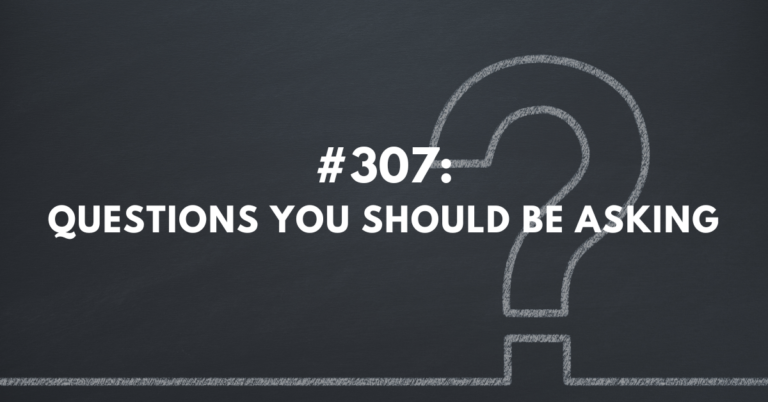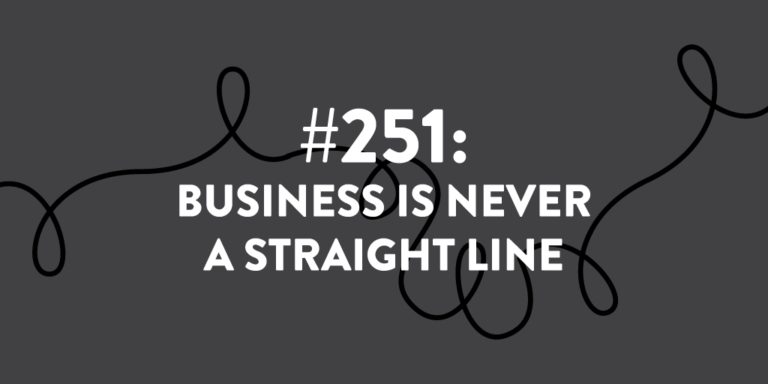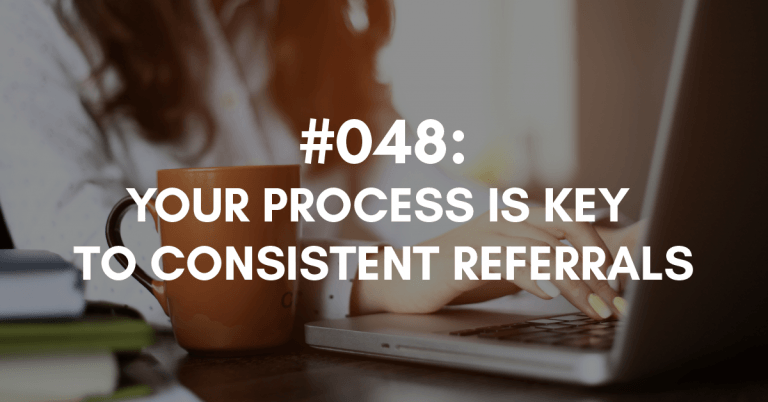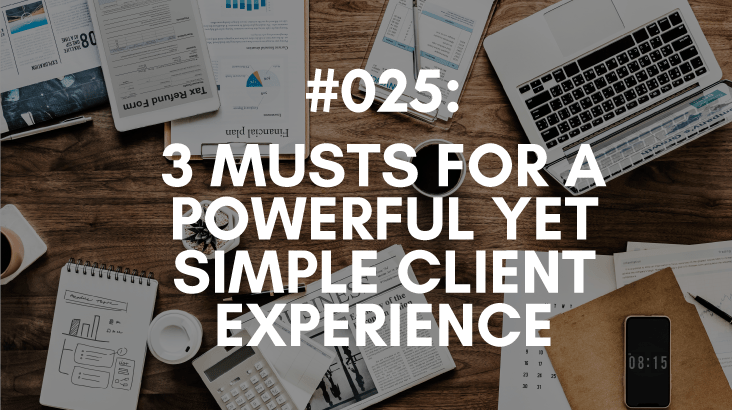Ep #269: Making Tracking Sexy Again
Why do I want to make tracking sexy?
Wait until you see the value and the results of your tracking, and then you might get a better understanding of why it can be so valuable and possibly even… sexy. Yep.
There are so many situations that I see and hear about where decisions are made without solid data to back them up. This is a problem, and in this episode, I’ll explain why this is so common and how it slows your growth.
Listen in to hear about an important framework (based on data) that will help you assess whether or not what you’re doing is working. I’ll also share how you can go about tracking in the most effective ways—even when you have limited time and resources to do so. As business owners, we tend to get taken in by the easy button, and I’m here to make sure you’re truly digging in to find what is most valuable to your business.
Links Mentioned During the Episode:
Join the Summer School for Referrals waitlist now so you can access the recordings from each class along with the resources to support you.
Submit your application to join us inside Building a Referable Business™ coaching program.
Next Episode:
Next episode is #270, where I’ll be answering some recently submitted questions.
Download The Full Episode Transcript
Read the Transcript Below:
Stacey Brown Randall: I know, I know I always say there’s nothing sexy about tracking data, but after you listen to this episode, you might just change your mind.
Hey there, and welcome to episode 269 of the Roadmap to Referrals Podcast, a show about helping you build a referable business. I’m your host, Stacey Brown Randall.
My journey from a business failure to a successful business now 10 years in, I know generating referrals naturally and consistently has made all the difference. Working with clients around the world, we leverage the science of referrals, protect relationships above all odds, and help you build a referable business.
When I told my friend about the title and topic of this episode, she said, “You might want to reconsider your definition of sexy, Stacey.” And she is probably right.
So, why do I want to make tracking sexy? Well, not because actually tracking individual pieces of data is sexy, but when you see the value in it, when you understand the results that come from it, that allow you to make better decisions, well, let’s be honest, you are more likely to follow through on keeping the tracking going.
So, maybe sexy isn’t the right descriptor, so you’re just going to have to go with me on this one. I keep having conversations where decisions are made that aren’t based on facts or even partial facts.
It happens a lot when people tell me about their referral sources. They’ll be like, “Oh, I have like five or six referral sources.” And then they do the work and they’re like, “Oh my gosh, that’s not true.” Or, “Oh, yeah I get about 30 to 35 referrals a year.” And then they realize what a real referral is, and they go through their actual mechanism to track it correctly and they realize, nope, they get about 10 a year.
So, with these conversations that I keep having where decisions aren’t based made on facts, what I find is that then opinions are formed based on anecdotal evidence or early indicators and feedback without digging into what’s really going on.
So, I wanted to spend this episode with you, giving you a framework of how to assess based on data tracking if what you are doing is working.
Now, this will go a little bit larger than the idea of tracking referrals and we’re going to look a little bit more bigger picture as we go through this. So, if you’re ready, let’s go.
On last week’s episode, I mentioned a client who had a month earlier in the year where they didn’t receive one single referral. They could have panicked, but what they did was go back to their referral tracker that I’ve had them using for years and compare. And that instantly calmed them down because they had benchmarks in place.
They were tracking their information, they were tracking data, and they could see that that month for whatever reason, is always a down month.
Now, nobody wants to receive zero referrals in a month, and I know that could send panic through anybody. But the truth is that month was never a good month for them, and their data showed that that’s normal. I mean, not fun to receive, but normal. And then of course, the next month it righted itself.
Now, reviewing benchmarks as a reflection of what’s happened and tracking data as it’s happening, it’s a snapshot of what’s going on. But when you take those two things combined, it’ll always help you make better decisions moving forward.
And sometimes, the better decision is just calming yourself down, because even though you don’t love what’s happening, it makes sense that it’s happening. Or sometimes, it gives you an idea of maybe we should try to fix this from continuing to happen.
So, I want to share a conversation I had with you who was sharing with me a new sales strategy that she was trying out. After she detailed it out to me, I asked her, “So, how’s it going?” And then she said the words I always receive with reservation, I could feel myself tense up as she said these words to me. And she shared, “Oh, people are responding positively, so it’s going great.”
Now, don’t get me wrong; positive responses are great, but they don’t always put money in your pocket, especially early positive responses. And of course, obviously, if things are not going great, that early feedback is what you need so that you can make adjustments. But what I find is that many people will take that early feeling, those positive responses, that good feedback that they are getting as something is working. But what if it’s not?
Let’s break down what I told her on what to track, so you can modify the framework to fit any sales activity, including referrals that you want to tackle and try out.
Hey, pardon the interruption, did you join us for summer school? In July, I taught three classes on what you need to know about referrals. If you missed our summer school classes, you can still dive in where I unpack the definitions you need but folks often confuse.
The science of referrals, the ecosystem of referrals within your business, guide you through an activity to uncover your referral gaps, plus your low-hanging fruit, and show you how to create a game plan that you can move forward with.
Go to staceybrownrandall.com/summerschool to put your name on the wait list. As soon as we finish breaking down the classes into bite-sized learnings, think mini lessons, you’ll be able to access it. It’ll be available very soon. The wait list again is staceybrownrandall.com/summerschool.
Okay, now back to the episode.
Alright, breaking down what you want to track so you can modify this framework to fit any sales activity. The first thing we need to do is we need to get okay with keeping detailed tracking. I asked her to get really specific in the results she was after, which allowed her to get really specific in what she would need to ultimately track.
We kind of need to work backwards here; what’s your ultimate objective? And then work backwards to figure out exactly how you can track if that’s happening.
The key here though, is to focus on the outcome, like where do you want to be? What do you want to have happen? And then of course, back into the data points that you then will track.
So, you had to define the expected outcome. And so, when you think about defining the expected outcome, you’ve got to figure out exactly what you’re wanting out of it. Who are you trying to receive as a part of this activity?
Now remember, we’re staying in the sales arena with this framework. I’m not saying you can’t take this framework and modify in other areas of your business, but we’re not talking about say, your operations or communication. What we’re talking about is from a sales perspective.
So, if you’re looking at this activity that you’re doing, what are you trying or more, should I say who are you trying to receive as a part of this activity? Are you looking to receive prospects, potential clients? Are you looking to get more referral sources?
What about just connectors that can just connect you to other people? Are you looking for exposure to an audience to grow your brand? These are all different things that you consider within the expected outcome of a sales activity that you may be doing.
Once you’ve determined your outcome, here’s some of the things I told my friend to consider tracking. Number one, how many new prospects, meaning not only how many new prospects did you come into contact with because of this activity that you’re doing, but then, how many of them became paying clients?
Now, here’s the thing about tracking outcome of new prospects. The ultimate goal is to track, “Hey, I got 10 prospects and five of them became paying clients.” The other thing to consider though, is how many of those prospects are not ready yet, but they’re worth following up with later?
So, using this example, if we did an activity that brought us 10 prospects and five became clients, awesome, we still have another five. It’s important for us not only to recognize those that maybe weren’t a fit or said no right away, but maybe some of those prospects who are actually just not ready yet, and we need to make sure we’re tracking that information and we’re tagging them correctly, so we can follow up with them later if we deem that to be important.
Another thing to consider with your tracking is, are you looking for new referral sources? I have a lot of folks who come to me and they’re like, I need to get more referral sources. And the idea is that people will try a lot of different things to have folks start to refer them. So, the question is, well, did you get any?
Now, you can’t become a referral source until someone actually refers someone to you. So, that means, if you’re going to track this, did they start referring you to prospects, potential clients? That’s something we want to track.
Sometimes the activity you do isn’t directly to the prospect, it’s to the person, the referral source, who knows the prospect. So, it’s important that we follow up and figure out, “Okay, this activity that I did, attending this networking event or meeting with these folks, they didn’t necessarily net me prospects, but I was ultimately after people to refer me, and they did connect me to folks who could actually refer me.” That’s something to consider.
Here’s another thing to consider tracking; how many new connectors? Here’s the thing about the difference between connectors and referral sources. A referral source is actually going to refer you a prospect that has the potential to spend money with you.
A connector though, may not ultimately refer you clients, but they may connect you to other people, other COIs, other centers of influence that can help you grow your network.
And I find that is just as valuable. I recognize it’s like a few degrees of separation from the idea of getting to the referral source who can then get you to the prospect who can become the paying client. But sometimes, people know a lot of other people and you would just love to operate and hang out within their orbit.
And so, they’re introducing you, connecting you to other people that can then could have the potential to continue to grow your network or to connect you with referral sources can be just as powerful, especially depending on how many people you have referring you now and if you need more people and how big or how small your network is.
And this can be considerably true if you’re starting in a new area, or if you are starting a new company, going in a different direction, then your network maybe knows about you.
So, sometimes we need to look for the connectors before we can then get to the referral sources before we can then get of course, to the prospects.
And here’s another thing to consider tracking; exposure to an audience. Now, here’s the thing, this is definitely harder to track, but if you’re asking the question, “Hey, where did you hear about me?” When you’re having a conversation with someone, even if it’s not a prospect or a client, it could just be someone who’s now connected to you, how did you hear about me or where did you hear about me? You can definitely put some data around where you’re spending your time.
So, here’s the thing I want you to consider — you can use this no matter what sales, marketing, prospecting, referral activity you’re doing, but you’ve got to consider the outcome.
If you’re deciding to join a bunch of networking groups, what is the outcome that you’re going in with? Yes, growing your network is important and knowing what that looks like in terms of meeting more people and meeting more connectors, but is it eventually supposed to lead you to referral sources and potentially then prospects?
Well, you’ve got to be tracking that, because here’s the thing; when you start going to new networking events and you start meeting people and everyone’s like, “Oh, it’s great to meet you, we should get together for coffee,” you can start feeling like things are moving in the right direction, but that’s an early indicator. What I want you paying attention to is like what actually is happening on the backend?
You can go to a networking event, meet a whole bunch of people, have a lot of folks say, “Let’s grab coffee, and then nothing ever happens.” And in some cases, even when you follow up with people to have coffee with them, nothing happens. And the idea there is, is to make sure you understand what is your expectation and how well are you tracking.
Now, how you track is completely up to you, whether you use a CRM, a complicated one or a basic one, whether you track this stuff on an Excel spreadsheet or a Google spreadsheet or maybe you just track this on a good old-fashioned piece of paper.
Here’s what I typically see happen with business owners. They get so busy just doing the thing, doing the work, trying to get everything going, that when they look back on what they have done, they don’t actually know if it’s been beneficial. And when you have limited time and limited resources, it’s important that we recognize what is working and quite possibly, maybe what’s not working.
Now, there is a difference between each of these; tracking prospects, tracking referral sources, tracking connectors or tracking exposure to one audience. There are differences between each, and each are important in their own way. So, to make sure you are tracking the outcome, you just need to make sure your tracking mechanism includes an outcome piece.
So, like in a spreadsheet, let’s just say for sake of argument, I was doing this in a spreadsheet. I would be tracking whatever it is I was doing, but I would have an outcome column because I need to know if I’m getting to the ultimate outcome.
If I go to a networking event and I meet seven people that are like, “Let’s grab coffee,” I need to be tracking how many of them did I actually go to coffee with? How many of them do I actually think there’s something there? Whether that is because maybe they’re going to become a prospect, or they’re going to become a new referral source, or they have the potential to refer me, or maybe they’re just a connector. I need to be tracking that outcome so I can see if it’s worth it.
And that takes time, and sometimes, as business owners, we just go looking for the easy button, and that’s not necessarily what we should be doing.
Here’s the thing; I’m sharing this because I find so many people do sales activity, outreach, promotions, networking, and they judge it based on the front end of the funnel, so to speak.
On what’s happening, that early feedback, those promises, those connections, the feeling, the sense they have when they start something, and they get good feedback in the beginning. But they’re not always really digging in to see how well it’s working on the backend, and that means the results. Is whatever you’re doing, getting you to what you ultimately want? Because if it’s not, you’re quite possibly wasting time.
So, you may need to modify this framework to fit the activity that you are doing currently in your business to figure out what is my outcome to this activity, and then how do I want to track if it’s being successful, and then actually doing the tracking. But here’s what I’ve learned …
The 10 years of having people do a basic tracking for me in terms of being able to identify who their referral sources are by tracking backwards where their clients and prospects come from, it’s one of the most empowering things people do.
And so, I know when we understand this information, we know where things are coming from, we know how things are happening, and we have an objective when we decide to do something, we’re A, much more likely to stick with it.
And B, it’s important that we recognize that we make better decisions when we know what’s actually happening. For better or for worse, we will make better decisions whether the data’s good or not, if it was what we were hoping for or not what we were hoping for. And that’s important for us to recognize.
So, remember, early feedback, especially if it’s positive, is great and it’s promising, but that doesn’t necessarily mean it’s a full story as to if something’s ultimately working. And I want to make sure you don’t fall to the trap of early feedback, giving you the idea that something is working until you’re actually tracking it all the way to the backend to make sure you’re getting the results you ultimately want, which means you’ve got to do some tracking.
And I hope this helps you understand the importance of it. Maybe it doesn’t make tracking sexy for you, but I do hope you understand the importance of it. If you’re going to spend your time, pay attention to the outcome, your time is limited as a business owner, and you deserve to make sure that what you are spending your time on is ultimately working.
If you want to know more, you can join us at staceybrownrandall.com/269. That is the show notes page for this episode, so you can find more information that we talked about today, including the full transcript, if you would rather see this stuff in black and white as you create your tracking framework.
Coming up next week is episode 270, and it’s a 10th episode. So, we have a Q&A episode on its way. That’s right, I’m going to answer some recently submitted questions.
Until then, you know what to do, my friend, take control of your referrals and build a referable business. Bye for now.






